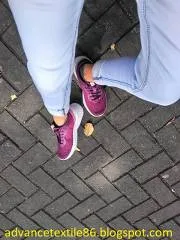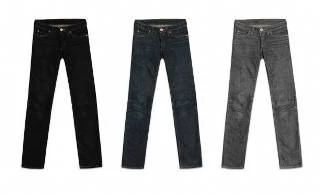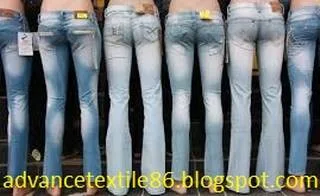Jeans
Jeans
are a type of pants or trousers that is made of denim or dungaree fabric. Often
the term jeans refer to a specific style of trousers, known as blue jeans that
were invented by Jacob W. Davis in 1871 in partnership with Levi Strauss &
Co and patented by Jacob W. Davis and Levi Strauss in May. 20, 1873. Before
Levi Strauss's patent trousers, the term blue jeans were long used for a
variety of garments made from blue denim.
Jeans History
Studies
of the Jeans, fabric trade shows that it originated in the cities of Genoa,
Italy, and Nîmes, France. Gênes, the French word Genoa, is probably the origin
of the word jeans. The weavers in Nemesis tried to reproduce the gin fabric but
instead created a similar towel fabric known as denim from de Nîmes, meaning
from Nîmes. Genoa Jean's fabric was a Fustian textile of medium quality and
reasonable price, very similar to the cotton corduroy for which Genoa was
renowned and usually used for clothing. The Genoese Navy equipped its sailors
with jeans because they needed a fabric that could be worn wet or dry. Nimes'
denim was thick, considered high quality, and was used for smoking or overall
size clothing. In 1576 a large number of jean fustians arrived at the port of
Barnstaple on a ship from Bristol. Almost all the indigo needed for coloring
came from the planting of indigo shrubs in India in the late 19th century. It
was replaced by the blue synthesis method developed in Germany.
Properties of jeans
i.
Jeans are very strong and durable garments.
ii.
It is feeling hard during wearing, if not after-treatment like a wash.
iii.
Jeans are fabric is hard so crease easily.
iv.
It is warp-faced twill, the colored warp yarns predominate on the face and the
white weft yarns on the back, another type are also visible.
v.
Usually, the warp is colored and the weft is white.
vi.
It is used for a long time wearing.
vii.
It resists wear, tears, and snags.
Types of jeans
Skinny jeans
Skinny
jeans have a snug fit on the legs and a short leg opener that can range in size
from 9" to 20" depending on the size anywhere. Skinny jeans are
completely tapered under the feet, whereas drainpipe jeans are skinny but the
bottom is straight instead of tapering and so they are often slightly baggy
under the feet than skinny jeans. Skinny jeans first appeared in men's fashion
in 2008. It continues into the 2010s, which have become popular since it
entered mainstream fashion in 2011, and has finally become one of the defining
fashion pieces of the decade for both men and women. They have become so
popular that many men have expanded their outfits to include tight-fitting
chino trousers that come in a variety of colors but often khaki, brown, or
white. Women’s skinny jeans have seen the high-waist trend return to style.
Women's skinny jeans, like men's, come in a variety of colors, often khaki and
neutral colors like white.
Straight-leg jeans
The straight leg of the straight-cut jeans has a straight up and down fit. Straight
jeans can be on the baggy side, such as boyfriend jeans or relax-fit jeans, or
fitted side knees and ankles like slim-fit jeans give more breathing. There are
truly simple cuts, where the width of the hem is straight from the buttocks to
the ankles. The waistband is between the super-tight fit of the skinny jeans
and the loose sleeves of the boyfriend jeans. A simple or bootcut silhouette is
really the most flattering to draw attention to your long sleeves. If you are
wearing cropped jeans in warm weather, avoid a pair of ankle lengths.
Bootcut jeans
Bootcut
jeans with short sleeve tops with a round or V-neck look great on flowing
materials like lace, silk, cotton, or linen. Get the top of the injury just
below your waist to keep the jeans bootcut balanced. If you’re wearing
high-waisted bootcut jeans, you can also opt for cropped and flowing tops. A
bootleg at the knee is narrower than opening the leg. Manufacturers often
consider anything with a leg opening between 17 and 20 as a bootcut jean
however it depends a bit on how wide the knee is Bootcut jeans are always a
good choice because this basic fit will always be in style. Bell-bottom jeans:
Bell-bottom jeans have a snug fit through the thigh and flare out from the knee
to the leg opening.
Wide-leg jeans
Wide-leg jeans are colloquially called baggy pants, which are a style of clothing that was popular from the late 1990s to the mid-2000s. Wide-leg jeans are cut wide across the entire leg, begin to learn around the mid-thigh, and then continue to open the wide leg. The difference between wide-legged and bell-bottom jeans is that bell-bottom jeans are larger than the size of an hourglass because they are tighter around the thighs and knees, while wide-legged jeans are more triangular in size because the flare is more gradual. Wide-leg Jeans and pants have a hem girth of at least 20". Wide-leg jeans can be considered a variant of baggy jeans, which were also popular in the 1990s. Super wide-leg jeans have a circumference at the hem of 23" to 26", however, the final wide-leg jeans are as wide as 50".
High-rise jeans
High-rise
jeans, also known as high-waist jeans, sit around your belly button at your
natural waist. High-rise, straight-leg jeans were a popular style in the ’80s
and 90s, making them known as mom jeans in the 2000s. At once the retro look is
back in style again, as a good pair of crop tops or a tee-in t-shirt with
high-rise jeans. Any woman 5 feet 10 inches or older knows that length is the
most important feature of a good pair of pants. High-rise wide-legged jeans are
here for 2020 and I’m pretty happy about it. You don’t like to hit your
wide-leg denim on the floor or crop it up unless it’s high-waisted but you’re
fine. This style of denim is perfect to pair with feminine blouses or cropped
sweaters.
Mid-rise jeans
Mid-rise
jeans have a waistband that sits just below the natural waist, in the middle of
the hips, and navel. Mid-rise jeans cover the lower abdomen more than low-rise
jeans, but high-rise jeans do not. This is the most image-friendly emergence
there; A bit of a secret weapon for all of us who are comfortable for all body
types and want some more structure around our intercourse. Mid-rise jeans are
really compatible with almost any top length, which makes them great to look
around.
Low-rise jeans
Low-rise
jeans feature a waistband that stays on the hips. They do not fit the natural
waist; In fact, they are sitting below the waist. These show a small increase
from just below-the-waist jeans, mid-rise or high-rise jeans feature low-rise
jeans that are not good for everyone. In fact, they can be scary if not worn properly.
They can be sexy if you are wearing the following jeans properly. With the
right accessories and a good fit low-rise jeans may leave you looking like
a million bucks. Most people would agree that low-rise jeans look better than
medium-rise and high-rise jeans. This body type can play around with the
emergence of many genes and will look beautiful in most cases. If you want to
add the curve of a tall, slender female feminine while lengthening your torso
to balance the long legs, a low-raised jeans will curve your hips and buttocks.
Having said all this, the low-growth trend will not scare you. That doesn’t
mean your favorite medium and high-rise jeans will disappear, and it doesn’t
mean you have to go back to any aesthetics from 20 years ago.
Jeans for men
Comfortable
Fit Jeans Size one up to get a comfortable fit so that your jeans do not
stretch with your curls. Straight-leg jeans with high growth maintain equal
width from the hips to the hem. Loose jeans with wide legs and seating offer a
comfortable option for a casual appearance.
The
best jeans for men-
i.
Diesel Buster tapered jeans.
ii.
Ultra-soft jeans from Jean brand diesel.
iii.
Reese Jet Slim Jeans 'Stay Black' these black jeans stay black no matter how
much they wash.
iv.
A.P.C. Petit Standard
V.
Polo Ralph Lauren Sullivan Slim Stretch Jeans.
vi.
Levi's 501 is original.
vii.
All saints Carter Straight Leg Jeans.















0 Comments